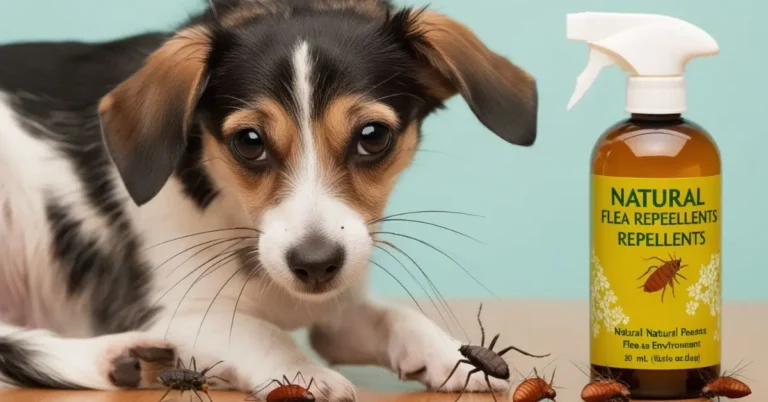Fleas are tiny, parasitic insects that can cause significant discomfort to both pets and their owners. These pests are known for their biting behavior, which can lead to itching, allergic reactions, and in severe cases, diseases. Traditional chemical-based flea repellents, while effective, often come with side effects and environmental concerns. As a result, many pet owners and eco-conscious individuals are turning to natural flea repellents as safer, more sustainable alternatives. This article explores various natural flea repellents, their effectiveness, how to use them, and tips for maintaining a flea-free environment.
Understanding Fleas and Their Impact
Before diving into natural flea repellents, it’s essential to understand the nature of fleas and the challenges they present. Fleas are wingless insects that feed on the blood of mammals and birds. They are incredibly resilient and can survive in various environments, making them a persistent problem once an infestation begins.
Fleas can cause several issues, including:
- Itching and discomfort: Flea bites can lead to intense itching and irritation for both pets and humans.
- Allergic reactions: Some animals and people are allergic to flea saliva, which can cause allergic dermatitis, characterized by severe itching, redness, and inflammation.
- Disease transmission: Fleas are known carriers of several diseases, including tapeworms, cat scratch fever, and even plague in some parts of the world.
- Anemia in pets: Severe flea infestations can lead to significant blood loss, especially in young or small animals, potentially leading to anemia.
Given these potential health risks, controlling and preventing flea infestations is crucial. While chemical repellents are commonly used, they can pose risks to pets, humans, and the environment. This has led to growing interest in natural flea repellents, which are perceived as safer and more eco-friendly alternatives.
Why Choose Natural Flea Repellents?
Natural flea repellents offer several advantages over their chemical counterparts:
- Safety: Many natural repellents are made from ingredients that are non-toxic to humans, pets, and the environment. This reduces the risk of side effects such as skin irritation, allergic reactions, or poisoning.
- Eco-friendliness: Natural flea repellents are often biodegradable and do not contribute to environmental pollution, unlike synthetic chemicals that can persist in the environment and harm wildlife.
- Cost-effectiveness: Many natural flea repellents can be made from common household ingredients or purchased at a lower cost than commercial chemical products.
- Versatility: Natural repellents can often be used in various forms—sprays, powders, shampoos, or even as dietary supplements—offering multiple ways to protect pets and homes.
Common Natural Flea Repellents
Several natural ingredients and products have been found to repel or kill fleas effectively. Below, we explore some of the most popular natural flea repellents and how they work.
1. Essential Oils
Essential oils are concentrated plant extracts that have been used for centuries for their therapeutic properties. Many essential oils are known for their insect-repelling abilities, making them popular choices for natural flea control.
- Lavender Oil: Lavender oil is a popular natural flea repellent due to its pleasant scent and calming properties. It’s also known for its ability to repel various insects, including fleas. You can apply diluted lavender oil directly to your pet’s fur or add it to their bedding.
- Cedarwood Oil: Cedarwood oil is another effective flea repellent that disrupts the pheromones that insects use to navigate. It can be used in a spray form or added to a pet’s shampoo.
- Peppermint Oil: The strong scent of peppermint oil is known to repel fleas and other pests. It can be diluted and sprayed on pets, furniture, and carpets.
- Eucalyptus Oil: Eucalyptus oil has a strong scent that fleas find unpleasant. It can be used similarly to other essential oils, either as a spray or added to shampoos.
Note: Essential oils should always be diluted before use, as they can be potent and cause skin irritation or toxicity if applied directly in their concentrated form. Also, some essential oils can be toxic to cats, so it’s important to consult with a veterinarian before using them on or around pets.
2. Diatomaceous Earth
Diatomaceous earth (DE) is a natural powder made from the fossilized remains of tiny aquatic organisms called diatoms. It is a popular natural flea treatment due to its ability to kill fleas by dehydrating them.
- How It Works: DE works by absorbing the oils and fats from the exoskeletons of insects, leading to dehydration and death. It is effective against fleas at all stages of their life cycle.
- Application: Sprinkle food-grade DE on carpets, pet bedding, and other areas where fleas may be present. It can also be lightly applied to your pet’s fur, though care should be taken to avoid the pet inhaling the powder.
- Safety Considerations: Only food-grade DE should be used around pets and humans, as the industrial-grade version can be harmful if inhaled.
3. Apple Cider Vinegar
Apple cider vinegar (ACV) is a well-known natural remedy with numerous health benefits, including flea control.
- How It Works: The acidic nature of ACV makes the environment less appealing to fleas. It can be used both topically and as a dietary supplement for pets.
- Application: ACV can be diluted with water and sprayed onto your pet’s fur, or added to their drinking water (in small amounts) to make their blood less appealing to fleas.
- Additional Benefits: Besides repelling fleas, ACV can improve your pet’s coat and skin health.
4. Neem Oil
Neem oil, derived from the neem tree, is a potent natural insecticide and repellent used in traditional medicine for centuries.
- How It Works: Neem oil disrupts the life cycle of fleas, preventing them from laying eggs and feeding on your pet. It also has antibacterial and antifungal properties that can help heal flea bites and skin irritations.
- Application: Neem oil can be mixed with shampoo or diluted with water to create a spray. It can be applied directly to your pet’s fur or used to treat flea-infested areas.
- Safety Considerations: While neem oil is generally safe, it should be used in moderation and with care, as it has a strong odor and can be toxic if ingested in large quantities.
5. Lemon Spray
Lemons are a natural flea repellent due to their high concentration of limonene, a compound that fleas find repulsive.
- How It Works: Limonene in lemons acts as a natural insecticide, repelling and killing fleas on contact.
- Application: To make a lemon spray, slice a lemon and steep it in hot water overnight. The resulting liquid can be sprayed onto your pet’s fur, bedding, and other areas where fleas are present.
- Additional Benefits: Lemon spray can also leave your pet’s coat shiny and fresh-smelling.
6. Rosemary
Rosemary is an aromatic herb that has natural flea-repelling properties.
- How It Works: The strong scent of rosemary is unpleasant to fleas, making it an effective repellent.
- Application: You can create a rosemary rinse by boiling the leaves in water, allowing it to cool, and then applying it to your pet’s fur after bathing. Alternatively, dried rosemary leaves can be crushed and sprinkled around your home.
- Additional Benefits: Rosemary also has antioxidant properties that can benefit your pet’s skin and coat.
7. Garlic
Garlic is often touted as a natural flea repellent when included in a pet’s diet, although its use is somewhat controversial.
- How It Works: Garlic is believed to make a pet’s blood less appealing to fleas when consumed in small quantities.
- Application: Garlic can be added to your pet’s food in small amounts. However, it’s important to note that garlic can be toxic to pets, especially cats, if given in large quantities. Always consult a veterinarian before adding garlic to your pet’s diet.
Creating a Flea-Free Environment
Using natural flea repellents is only one part of the equation in controlling and preventing flea infestations. Maintaining a clean and flea-free environment is equally important. Here are some tips to help create a flea-free home:
1. Regular Cleaning
Frequent cleaning can significantly reduce the chances of a flea infestation. Here’s what you should do:
- Vacuuming: Vacuuming carpets, rugs, and furniture regularly helps to remove flea eggs, larvae, and adults. Be sure to empty the vacuum bag or canister immediately after vacuuming to prevent fleas from escaping.
- Washing Pet Bedding: Wash your pet’s bedding and other frequently used fabrics (like blankets and cushions) in hot water weekly. This kills fleas and their eggs.
- Steam Cleaning: Steam cleaning carpets and upholstery can help kill fleas at all life stages. The heat from the steam is effective in eliminating fleas.
2. Outdoor Maintenance
Fleas often come from outdoor environments, so maintaining your yard is crucial:
- Mowing the Lawn: Keep your lawn well-trimmed to reduce flea habitats. Fleas thrive in tall grass and shady areas.
- Removing Debris: Clear away leaf litter, wood piles, and other debris where fleas might hide.
- Using Nematodes: Beneficial nematodes are microscopic worms that feed on flea larvae. They can be applied to your yard to help reduce the flea population naturally.
3. Pet Hygiene
Regular grooming and hygiene practices can help keep fleas at bay:
- Bathing: Regular baths with natural flea-repelling shampoos can help remove fleas from your pet’s fur. Be sure to use lukewarm water and a flea comb during the bath.
- Brushing: Use a flea comb to brush your pet’s fur regularly. This helps to remove fleas, eggs, and dirt. Focus on areas where fleas tend to gather, such as around the neck, tail, and belly.
- Diet: A healthy diet can boost your pet’s immune system, making them less attractive to fleas. Adding natural supplements like fish oil, which contains omega-3 fatty acids, can improve skin health and repel fleas.
Potential Challenges with Natural Flea Repellents
While natural flea repellents offer many benefits, they also come with some challenges:
- Effectiveness: Natural repellents may not be as immediately effective as chemical treatments, especially in severe infestations. They often require more frequent application and may need to be combined with other methods for the best results.
- Allergies and Sensitivities: Some pets may be sensitive or allergic to certain natural ingredients, such as essential oils or herbs. It’s important to test any new product on a small area first and monitor for any adverse reactions.
- Consistency: Natural flea control often requires consistency and persistence. Unlike chemical treatments that can last for weeks, natural repellents may need to be reapplied frequently.
Conclusion
Natural flea repellents offer a safer and more environmentally friendly way to protect your pets and home from flea infestations. From essential oils to diatomaceous earth, there are numerous natural options available that can effectively repel and kill fleas. However, it’s important to approach natural flea control with a holistic mindset—regular cleaning, outdoor maintenance, and pet hygiene are all crucial components of a successful flea prevention strategy.
While natural flea repellents may require more effort and consistency than chemical treatments, the benefits of reduced toxicity and environmental impact make them an attractive option for many pet owners. By combining various natural methods and maintaining a clean living environment, you can keep fleas at bay and ensure the health and comfort of your pets and family.

